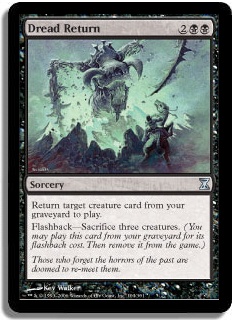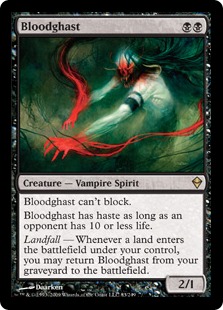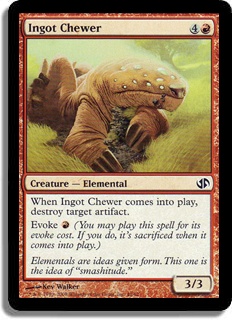Summer is just around the corner, and the short march to the North American Vintage Championship at Gen Con and the Bazaar of Moxen tournament has begun. The flagship tournaments may be months away, but the buildup is equally fascinating to watch unfold, as it ultimately informs the metagames of the championship tournaments.
In today’s article, I will discuss the latest 49-player LCV tournament (the results of which I find absolutely shocking) as well as my experience playing with Smennen’s Burning Tendrils deck in San Diego.
Oh, and did I mention Dredge won back to back?
LCV March Results and Analysis
If I had to pick one fictional character from a TV show that I can relate to, it would have to be Rick Grimes from AMC’s The Walking Dead. There are plenty of moments in the show where he stands at his post in the watchtower, deep in thought and observing the zombie horde polluting the landscape of his homeland. I know exactly what he is thinking as he observes the legion of undead that have destroyed everything he holds dear.
“This all could have been avoided if people had just played Rest in Peace.”
Dredge took down back-to-back LCV events, but that isn’t even close to the most shocking aspect of this Top 8…
1st
Jordi Carbonell (Dredge)
2nd
Miquel Alcoriza (Talrand Gush)
3rd-4th
Antonio Sanchez (Tezzerator)
Edu Medrano (Noble Fish)
5th-8th
Carles Minon (Bomberman)
Javi Rubio (BUG Loam)
Francisco Pina (U/R Control)
Toni Anaya (RUG Delver)
Notice anything fishy about this Top 8? Well, besides the fact that it is full of Fish decks (BUG, Delver, and Noble Fish), there are zero Mishra’s Workshop decks present.
Let’s take a look at the 9th-16th decklists to gain a broader perspective of last month’s field:
9th-16th
Joaquin Fernand (Turbo Tezz)
Gerard Piella (Dredge)
Sergi Cobos (Dredge)
Javier David (Espresso Stax)
Aleix Dosta (Grixis Control)
Pablo Ambrojo (Aggro MUD)
Marcel Milia (RUG Delver)
Roger Riera (Espresso Stax)
It looks like Catalonia is in the midst of a Zombie invasion, with Dredge having won two in a row and more Dredge decks congregating just outside the Top 8.
Creatures (25)
Lands (16)
Spells (19)
Sideboard

Notice anything interesting about Jordi’s deck?
“Combo? Why bother?”
The winning Dredge list had no Dread Return combo whatsoever and relied simply on the make Zombies the “fair” way and grind the opponent out plan. While this plan gives the deck a slower goldfish draw, it opens up a few more critical deck slots to consistency and getting the ball rolling.
“The Zombie horde sets its sights on Mirrodin…”
The use of Bloodghast + land (and not to mention four Ingot Chewer) gives this particular Dredge deck a better matchup against Workshop decks. Is it Dredge, of all things, that is pushing Mishra’s Workshop down in the LCV tournaments?
It probably isn’t Dredge specifically, but rather the fact that all of these decks seem to have very reliable plans for defeating Mishra’s Workshop. However, despite that fact, it is my belief that Shops is powerful enough to be able to push through a decent sideboard plan to consistently put one or two players into a Top 8. It may simply be that for the time being Workshops is underrepresented or simply catching some bad breaks.
The Dredge decks rose toward the top of the Top 16, and the Workshop decks sunk toward the bottom of the Top 16. Dredge is on the rise, and Workshops is on the decline—for now.
The rest of the Top 8 was comprised of various makes and models of blue decks. The decks with combo kills appear to have performed better than the Fish-style decks with relation to their position in Top 16. The Fish and Delver decks seem to have outperformed the Workshop decks but lost to the combo decks in the field. Granted, Turbo Tezz, Dredge (without Dread Return), and Bomberman aren’t exactly the pinnacle of pure combo, but they were the most combo decks at the top tables.
Of all the Fishy decks in the tournament, my favorite one is the BUG Fish deck:
Creatures (12)
Planeswalkers (2)
Lands (17)
Spells (29)

I love Deathrite Shaman and believe that he will continue to become a more important piece of Vintage as we move forward—especially when Workshops increases in popularity again.
Combo, Where Art Thou?
The fact remains that at the moment it appears (at least at this tournament) that combo was the place to be. Yet if the trend seems to suggest that combo out performed non-combo, why are there no pure combo decks?
It’s either that the Fish decks crushed it out of the tournament early or that it simply didn’t get played at this event. Either way, no combo is not what I would expect in a Top 16 that is arranged this way.
I have two predictions moving forward:
First, in a metagame like the Catalonia one, I predict that pure combo will do really well in one of the next two events. Smennen’s Burning Tendrils deck with four maindeck Oath of Druids would have been the best positioned deck in the Top 8 and very likely would have smashed the event.
Second, a lot more copies of Rest in Peace need to be played in Catalonia right now. It is clear that for at least the past 60 days Dredge has been the best deck in this region. Rest in Peace is the best card at beating the best deck.
Incidentally, both of my suggestions—play fast combo and play Rest in Peace—are the best ways of defeating Dredge in Vintage.
Dear LCV players,
Please play Rest in Peace. If I have to write “The Zombies Win Again, Again, Again!” I am going to be annoyed.
Cheers,
Brian DeMars
While I was in San Diego for the Grand Prix, I got a chance to play about ten games with the “Restricted List Combo Deck” against Grixis Control and was very impressed with the combo deck.
Creatures (2)
Lands (11)
Spells (47)
- 1 Brainstorm
- 1 Yawgmoth's Bargain
- 1 Vampiric Tutor
- 4 Oath of Druids
- 4 Duress
- 1 Necropotence
- 1 Mana Vault
- 1 Wheel of Fortune
- 1 Sol Ring
- 1 Demonic Tutor
- 1 Time Walk
- 4 Dark Ritual
- 1 Ancestral Recall
- 1 Mana Crypt
- 1 Windfall
- 1 Timetwister
- 4 Burning Wish
- 1 Mind's Desire
- 1 Memory Jar
- 1 Demonic Consultation
- 1 Tinker
- 1 Black Lotus
- 1 Lotus Petal
- 1 Lion's Eye Diamond
- 1 Mox Emerald
- 1 Mox Jet
- 1 Mox Pearl
- 1 Mox Ruby
- 1 Mox Sapphire
- 3 Chrome Mox
- 1 Ponder
- 2 Mox Opal

I ended up going 4-4 with the deck, alternating being on the play and the draw. A few things of note: I actually punted the first two games by making plays that were pretty terrible and lost when I could have won.
Lesson #1: The Burning Tendrils deck requires a lot of specific knowledge in order to play it correctly. Once I got the hang of it, my win percentage went up significantly as I got a better feel for what kinds of plays I needed to be making. The learning curve is high with this deck, but so is the payoff. If there is any deck that deserves a second look or is worth putting the time in for, it may very well be Burning Tendrils.
Another interesting thing about my testing was that my opponent was clearly cheating the whole time. He kept all eight of his opening hands of seven, all of which included Force of Will. To add insult to injury, four of his openers also had Black Lotus. I, on the other hand, mulliganed four times and never had Black Lotus in my opening hand.
Wah, wah, wah… Right? Wrong. I’m not complaining about my misfortune in playtesting, but rather I’m trying to communicate a point. I went 4-4 against one of my “worst matchups” where the opponent kept seven with Force of Will eight times in a row, two of his wins were due to my misplays, I mulliganed in half my games, and he had Black Lotus four times. The point is that against my opponent having pretty much his best possible draws and me having mediocre ones, with tight play I could have been 6-2. That is a really strong testament to how powerful the deck is.
I recommend playing the broken combo deck, at least for the time being until more people start playing it.
The upside is that you get to consistently win the game on turn 2. Unfortunately, the downside is that sometimes you don’t get to win until turn 3…
No matter what you do, don’t forget your Dredge hate!
Thanks for reading.
Cheers,
Brian DeMars



